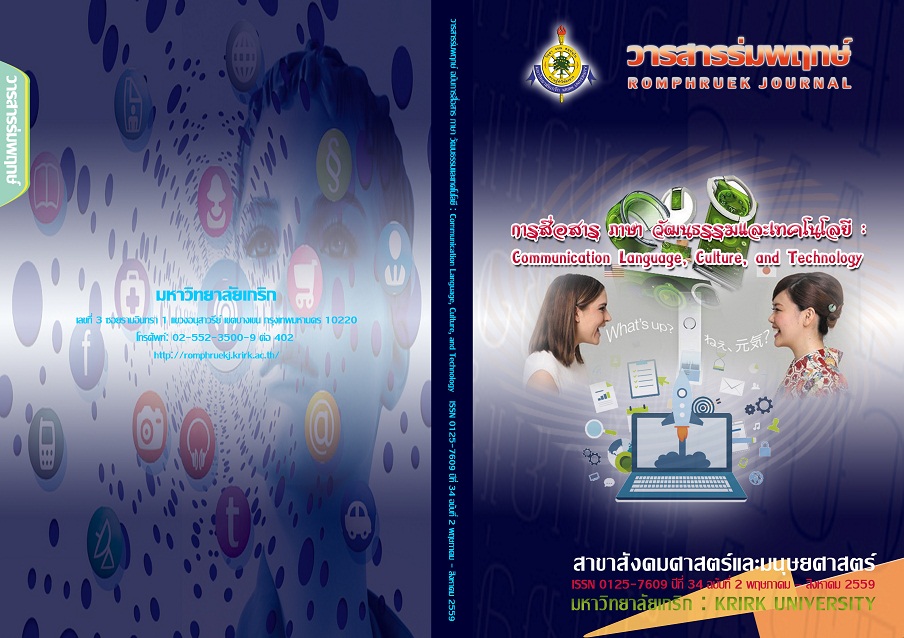พฤติกรรมการใช้สื่อสังคมออนไลน์กระจายข้อมูลในกลุ่มเยาวชน : Information Dissemination Behavior in Online Social Networks of Teenagers
Main Article Content
Abstract
สื่อสังคมออนไลน์เป็นแหลง่ รวบรวมข้อมูลจำนวนมหาศาลที่เกิดจากการติดต่อสื่อสารของมนุษย์ ยิ่งจำนวนผู้ใช้เพิ่มมากขึ้นเท่าไร ปริมาณข้อมูลที่หมุนเวียนในระบบก็เพิ่มขึ้นเป็นทวีคูณ ด้วยช่องทางหลักในการติดต่อเพื่อส่งผ่านข้อความไปยังผู้รับ ล้วนมาจาก การโพสต์ (post) การส่งต่อ หรือ การนำเสนอแนวคิดใหม่ๆ ซึ่งข้อมูลเหล่านี้ไม่เพียงแสดงความสัมพันธ์ของคนในเครือข่าย แต่ยังบ่งชี้ให้เห็นถึงศักยภาพการส่งผ่านข้อมูลที่เป็นไปอย่างรวดเร็วและทั่วถึง การศึกษาครั้งนี้เป็นการนำเสนอผลการวิเคราะห์พฤติกรรมการใช้สื่อออนไลน์ของเยาวชนในการเผยแพร่ข้อมูลของสถานศึกษาไปยังกลุ่มเป้าหมายที่สนใจศึกษาต่อ และบุคคลทั่วไป ข้อมูลที่ใช้ในการวิเคราะห์ คือข้อมูลพฤติกรรมการแบ่งปันข้อมูลผ่านสื่อสังคมออนไลน์ที่รวบรวมด้วยแบบสอบถามซึ่งผลการทดสอบ พบว่า กลุ่มผู้ใช้สื่อสังคมออนไลน์มีพฤติกรรมการเผยแพร่ข้อมูลใน4 รูปแบบหลัก คือ 1) กลุ่มชอบประชาสัมพันธ์ตัวเอง 2) กลุ่มบันเทิงรื่นเริง 3) กลุ่มนานาสาระ และ 4) กลุ่มรักสถาบัน โดยพบว่ากลุ่มที่จะเป็นประโยชน์ต่อการเผยแพร่ข้อมูลของสถาบันสูงสุด คือ กลุ่มรักสถาบัน อย่างไรก็ตามหากสามารถปรับเปลี่ยนรูปแบบการนำเสนอข้อมูลให้สอดคล้องกับความต้องการของกลุ่มอื่น การเพิ่มศักยภาพในการเผยแพร่ข้อมูลให้ครอบคลุมในวงกว้างย่อมเป็นเรื่องที่สามารถทำได้
Social media is a collection of vast amount of data generated by
human communication. As the number of users increase, the amount
of information circulated is also increased exponentially. Main channels
of data transmission are posing, forwarding, or presenting new ideas.
This kind of data not only shows the relationships of people in the
networks but also indicates their potentiality that data can be transmitted
fast and thoroughly through this media. This study aims to present
the analytical results of using online media to disseminate educational
information to the target audiences which can be both people seeking
further education, and any interested persons. Behavioral data and online
sharing behavior was collected by questionnaire. The results demonstrated
that social network users could be classified according to behavior in
sharing or publishing as follows : 1) self-promotion flock 2) entertainment
fan 3) material gang, and 4) institution squad. The group which provided
highest beneficial data to the dissemination process of the institute was
the institution squad. However, if the dissemination pattern of the institute
could be enhanced to fit with the needs of other groups, broader coverage
of dissemination could become possible.
Article Details
Every article published in the Romphruek Journal of the Humanities and Social Sciences is the opinion and point of view of the authors. Thery're not the viewpoint of Krirk University or the editored department. Any part or all of the articles for pablication must be clearly cited.
References
ขวัญชนก กมลศุภจินดา. (2558). พฤติกรรมการใช้สื่อสังคมออนไลน์และการแสดงตัวตนของเจเนอเรชั่น : กรณีศึกษาความแตกต่างระหว่างเจเนอเรชั่นเบบี้บูมเมอร์สและเจเนอเรชั่นวาย. (นิเทศศาสตรมหาบัณฑิต), มหาวิทยาลัยกรุงเทพ.
ภาณุวัฒน์ กองราช. (2554). การศึกษาพฤติกรรมการใช้เครือข่ายออนไลน์ของวัยรุ่นในประเทศไทย: กรณีศึกษา Facebook (วิทยาศาสตรมหาบัณฑิต), ม.ธรรมศาสตร์.
เสาวภาคย์ แหลมเพ็ชร. (2559). พฤติกรรมและผลกระทบจากการใช้เครือข่ายสังคมออนไลน์ของนักเรียนระดับชั้นมัธยมศึกษาตอนปลายในจังหวัดนนทบุรี. สุทธิปริทัศน์, 30(93), 116-130.
Berkhin, P. (2006). Survey of Clustering Data Mining Techniques. IEEE(Accrue Software, Inc.).
Boccalettia, S., Latorab, V., Morenod, Y., Chavezf, M., & Hwanga, D.-U. (2006). Complex networks: Structure and dynamics. Physics Reports, (424), 175 – 308.
Cheung, C. M. K., Chiu, P.-Y., & Lee, M. K. O. (2011). Online social networks: Why do students use facebook? Computers in Human Behavior, 27, 1337-1343.
Du, Z., Fu, X., Zhao, C., & Liu, T. (2012). University Campus Social Network System for Knowledge Sharing. IEEE(International Conference on Systems and Informatics (ICSAI 2012)), 2505-2508.
Duggan, M. (2015). The Demographics of Social Media Users. Mobile Messaging and Social Media 2015. 2015. สืบค้นจาก www.pewinternet.org/2015/.../mobile-messaging-and-social-media-2015. สืบค้นเมื่อ 1/1/2016.
Hawkins, D. M. (1980). Identification of Outliers : Chapman and Hall.
Jamil, S., Zehra, F., Naqvi, R., & Bhamani, S. (2013). Impact of Facebook Intensity on Academic Grades of Private University Students. IEEE, 1-10.
Lee, I., & On, B.-W. (2012). Community Detection for Large Scale Social Network Sites. IEEE.
Leelathakul, N., & Chaipah, K. (2013). Quantitative Effects of using Facebook as a Learning Tool on Students’ Performance. IEEE(2013 10th International Joint Conference on Computer Science and Software Engineering (JCSSE)), 87-72.
Lenhart, A. (2015, April 9, 2015). Teens, Social Media & Technology Overview 2015. 2015. สืบค้นจาก www.pewinternet.org/2015/04/09/teens-social-media-technology-2015 . สืบค้นเมื่อ 1/1/2016.
Russell, M. A. (2011). Mining the Social Web. O'Reilly.
Tang, T., Hämäläinen, M., Virolainen, A., & Makkonen, J. (2011). Understanding User Behavior in a Local Social Media Platform by Social Network Analysis. ACM(MindTrek’11 September 28-30, 2011, Tampere, Finland.), 183-188.

